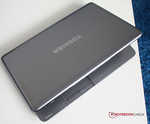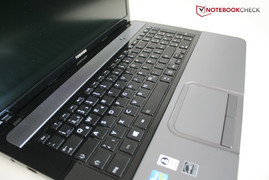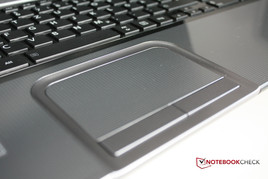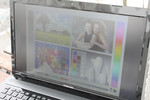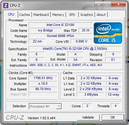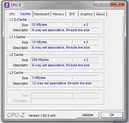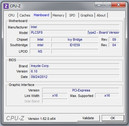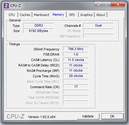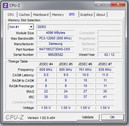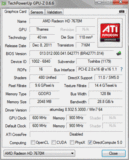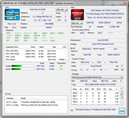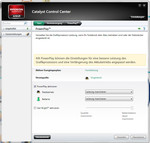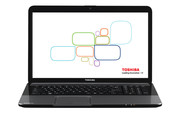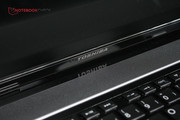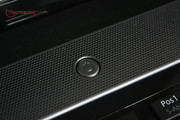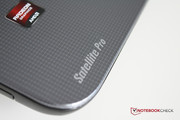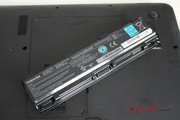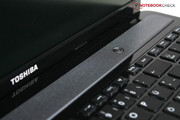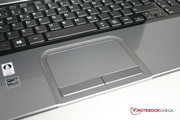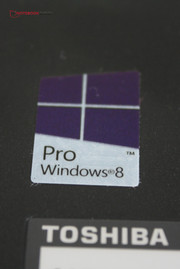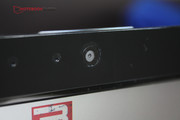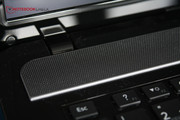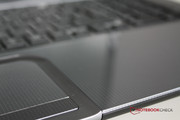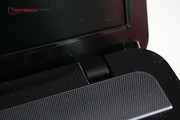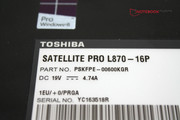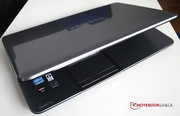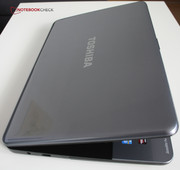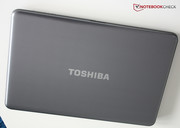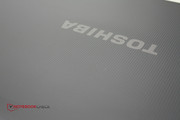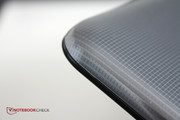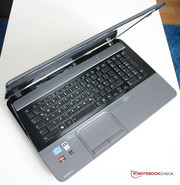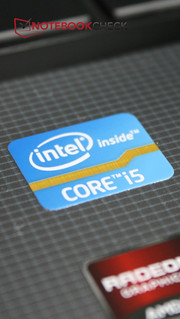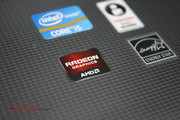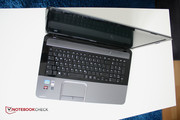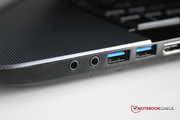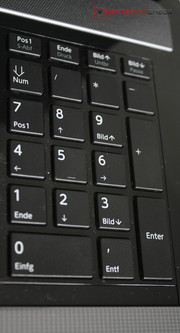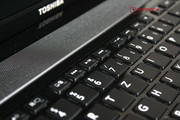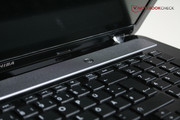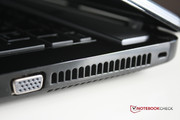Review Toshiba Satellite Pro L870-16P Notebook

For the original German review, see here.
Toshiba separates its office notebooks into three series. The Tecra and Portégé series' are aimed more at large companies and office users who need a practical notebook with many business features. It is not a coincidence that the Tecra series notebooks are reminiscent of the simple design of Lenovo ThinkPads, with a Touchpoint in the middle of the keyboard. The Satellite Pro series meanwhile traditionally includes more consumer orientated notebooks, with less security features and more multimedia potential, which therefore makes them better suited for the home office rather than for small companies.
It is therefore not surprising that Toshiba has allocated its only 17.3-inch notebook in the office segment to the Satellite Pro series, since large companies generally prefer more practical notebooks, as well as a docking station and a second display at the desk. The Toshiba Satellite Pro L870-16P on the other hand can be used as a full-fledged desktop replacement thanks to its large display, but thereby also has its mobility curtailed.
Our reviewed model contains an Intel Core i5-3210M processor with two cores, a dedicated AMD Radeon HD 7670M graphics card, 8 GBytes of RAM, a 500 GByte hard drive, and has a current retail price of 699 Euros (~$914).
As already mentioned, a 17.3-inch office notebook is not particularly common, which also means that there are not many competing devices: Toshiba themselves have a further similar model available in the form of the Satellite Pro C870, which is somewhat cheaper, but also provides less performance (Intel HD Graphics 3000, Intel Core i3-2350M). There is also the Acer Aspire 7739Z, which is also less potent (Intel Graphics Media Accelerator (GMA) HD Graphics, Intel Pentium P6200) and does not have a matte display. The HP Pavilion g7-2051sg could possibly be a rival in terms of processing power (AMD Radeon HD 7660G + HD 7670M Dual Graphics, AMD A-Series A10-4600M), but also has to make do without a matte display. Straddling the border between a multimedia and business notebook is the HP ProBook 4740s, which contains the same processor and graphics card as our reviewed device.
Since there are not a great deal of office features included anyway, the borderline buyer could also consider 17.3-inch multimedia notebooks: Sony's Vaio SV-E1712F1EW (Intel Pentium B980, AMD Radeon HD 7650M) would be one example of a possible option, as well as the Asus K75VJ (Core i7-3610QM, GeForce GT 635). The Dell Inspiron 17R SE meanwhile provides considerably more performance than our reviewed device with a similar starting price. None of the multimedia notebooks have a matte display though.
Case
All in all the case of our reviewed device is more or less the same as that of the Toshiba Satellite Pro C870, whereby it is merely a case of matte surfaces having been replaced by glossy surfaces. A good decision? If the cleaning lady in the office also wipes down the notebooks, then she will likely have mixed feelings about the Toshiba Satellite Pro L870-16P: On the one hand the notebook looks attractive on the desk with its gray pattern surfaces and black glossy case, while on the other these surfaces also attract a lot of fingerprints that will have to be cleaned off regularly in order to uphold the good appearance.
The chassis is altogether relatively stable and feels pleasant to hold. There are however also a few points of criticism: One of these is that the display lid can easily be dented inwards, something that does not make itself noticeable on the display itself thankfully though. Rigid hinges make it difficult to open the lid with one hand, and the display also wobbles for quite a long time after adjusting its position.
Overall, the case of the Satellite L870-16P is good and is suitable for daily use, despite some shortcomings. An example of a notebook that provides a better manufacturing quality in this price range is the HP ProBook 4740s.
Connectivity
Fortunately we can ascribe two USB 3.0 ports to the features of our reviewed notebook. Otherwise, the device provides the standard assortment of interfaces for notebooks in this price range. Among these most of the interfaces are located towards the front on the right side, which could be a source of agitation for right handed mouse users, especially since the DisplayPort and LAN socket are also relatively far towards the front. The left side merely has one USB 2.0 port towards the back, while the front similar to many other devices only contains a card reader that supports SD and multimedia cards.
Communication
In many cases, devices in this price range provide Bluetooth 4.0 for exchanging data with mobile phones or connecting wireless headphones, as in the case of the reviewed device. Also included, is Gigabit LAN for fast surfing, and a WLAN module from Artheros. At a distance of 10 meters (33 feet), and with three separating walls, the reviewed device's WLAN still worked satisfactorily with four reception bars in the Windows icon.
Security
Anyone looking for real security for sensitive information provided by a fingerprint reader and an encrypted hard drive will have to look elsewhere. Instead Toshiba has integrated some proprietary software solutions into the Satellite Pro series, which should at least provide basic security: The PC Health Monitor monitors important aspects of the system and raises alarms in cases such as when the battery is nearly empty, or if the processor cooling fails. There is also a tool for diagnosing problems with the device, and Recovery Disks can be created. Altogether the security features are however only suitable for smaller companies, where data security does not play an important role.
Warranty
As with most other business devices Toshiba only provides a 12-month warranty, although there is an additional free 12-month insurance against display damages for purchases before 31st March 2013, whereby repairs will be carried out free of charge.
Input Devices
Keyboard
As standard for a 17.3-inch notebook, a full-fledged 102 key keyboard with 16-millimeter (~0.6-inch) wide keys separated by 4 millimeters is included. The new 'menu' button, which opens the options for an area in Windows, is also on board, and can be used as a right-click in Windows 7.
There are no separate buttons for volume control or WLAN functionality, although the "F1"-"F12" keys serve this purpose. One special feature involves the "Caps Lock" and "Num Lock" keys: They contain an LED that illuminates when the respective function is enabled.
So how does the Toshiba Satellite Pro L870-16P fair when it comes to typing? Unfortunately worse than we would have hoped for from an office notebook: The keys have a very short travel, and do not give a clear indication of whether the key has been pressed or not. In addition to this, the keyboard also bends inwards across its whole width. The large keys and the clear layout on the other hand make a good impression, so that the keyboard is altogether satisfactory in our opinion. An example of how this could be improved is provided by the HP ProBook 4740s.
Touchpad
The touchpad meanwhile makes a noticeably better quality impression than the keyboard. On top of this, the lowered matte edges add to the visual appeal. Offset towards the left substantially, the amply dimensioned 10.5-centimeter (~4.1-inch) diameter surface is matte and provides pleasant gliding properties.
Underneath the touchpad are two separate buttons, which are even better in terms of the quality of the materials, and work reliably with a suitable travel and good feedback. Multi-touch gestures are also supported by the touchpad.
Display
Something that could definitely make the Toshiba Satellite Pro L870-16P an interesting choice for gamers is the matte display with a resolution of 1600x900 pixels. The colors may appear to be a little less brilliant compared to a glossy display, but annoying reflections are minimized. As with most affordable notebooks, the display utilizes the TN-LED technology, which causes brightness and colors to change when viewed from wider angles, such as from the sides and above or below.
Measurements taken with the Spectrophotometer X-Rite i1Display 2, which we carried out prior to the calibration with the tool CalMAN, showed that grayscales were not very well presented. A DeltaE 2000 of 16 on average indicates discoloration that even an untrained eye can recognize. The color saturation shows obvious distortions of magenta and cyan towards blue, which means that we are dealing with a TN display that shows the blue tint that is common with TN panels.
| |||||||||||||||||||||||||
Brightness Distribution: 87 %
Center on Battery: 239 cd/m²
Contrast: 368:1 (Black: 0.65 cd/m²)
52.6% AdobeRGB 1998 (Argyll 3D)
74.6% sRGB (Argyll 3D)
51.3% Display P3 (Argyll 3D)
The contrast of the display is reasonably good with a ratio of 367:1, and the maximum brightness of 252 cd/m² is relatively good compared to other devices in this price range. Although the brightness may be quite evenly distributed across the display with 87%, it is still about 15% brighter along the bottom edge than the upper area. Subjectively we didn't notice the brightness difference though.
When it comes to covering the different color spaces the expected shortcomings become apparent: Neither Adobe RGB or the smaller sRGB color space are even remotely covered, although it is worth bearing in mind that this is something that will only pose a problem for professional users.
In terms of outdoor use, the display of the Toshiba Satellite Pro L870-16P is able to score points thanks to its matte surface. On a cloudy day, it is possible to work outside without any problems. Only when the sun begins to reflect directly off the display does the average display brightness make itself noticeable: Not a lot can be recognized on the screen any longer.
As alluded to previously, the display panel in the Toshiba Satellite Pro L870-16P is not exactly ideal for showing things to several people at the same time. When looking at the display from the side for instance, the contrast quickly diminishes to the extent that details become hard to recognize with substantial discoloration, while this effect is even more pronounced when looking from above or below. The display behaves similarly to most affordable panels, and does not provide exceptionally wide viewing angles.
Altogether, the display is absolutely in line with its segment, although Acer has only just released the Aspire V3-571G-53214G50Maii 15.6-inch notebook with a high quality IPS panel for a similar price, which goes to show that it is also possible to include qualitative displays in this price range.
Performance
Buyers of the Toshiba Satellite Pro L870-16P can look forward to a potent configuration of mid-range components, which should be able to manage any tasks posed during office use without any problems. Included is an Intel Core i5-3210M, a dedicated AMD Radeon HD 7670M graphics card, and a generous eight GBytes of RAM.
Essentially the configuration within the series does not change a great deal, whereby the differences between the individual models are primarily constrained to the hard drive capacity and the operating system. There is however a model on the internet with the description Satellite Pro L870-177 (although not on the official Toshiba website), which has a substantially more powerful quad-core Intel Core i7-3630QM processor. We compared the two processors when we tested the Acer Aspire V3-571G.
Processor
The Intel Core i5-3210M is a frequently used dual-core Ivy Bridge processor, which can process up to four threads simultaneously thanks to Hyperthreading. The processor has a base clock speed of 2.5 GHz, but with the aid of Turbo Boost this can be dynamically increased to up to 2.9 GHz (both cores) or 3.1 GHz (single-core) if required.
Subjectively the system operates without any delays, and the processor should suffice for demanding applications and games. During the synthetic benchmarks with the Cinebench series, our reviewed device achieved precisely the expected scores, which were similar to those achieved by other devices with a Core i5 processor (e.g. HP ProBook 4740s). This indicates that the full Turbo Boost speed is utilized throughout the Cinebench benchmark, and we were indeed able to confirm this assumption following a short test. Even when battery powered the Turbo Boost remains available as long as the power plan "High performance" is selected. With the power plan "Power saver" selected, the processor operates at a mere 1.4 GHz if only a single-core is used. If both cores are used simultaneously, the processor still operates using the full Turbo Boost speed of 2.9 GHz.
System Performance
With the aid of the benchmarks PCMark 7 and PCMark Vantage, we tested how well the entire system can compete: In this case the processor performance, as well as the fast dual-channel RAM, hard drive speed, and the performance of the graphics card also play a part in the final result. Once again the Toshiba Satellite Pro L870-16P remains dependable in this scenario: Devices with an Intel Pentium B980 (Sony Vaio SV-E1) or the AMD A6-3420M (Samsung Series 3 305E7A) are significantly outperformed. The HP Pavilion g7, which is based on the AMD A10-4600M, lags behind by over 20%. The in-house competition in the form of the Satellite Pro C870 with an Intel Core i3-2350M and without a dedicated graphics card falls behind even further. Even the HP ProBook 4740s has to accept defeat due to the slower rotating hard drive and less RAM.
Compared to the other 17.3-inch office notebooks that we have reviewed recently, the Toshiba Satellite Pro L870-16P therefore provides a better system performance, which does however come at a price. In any case, our reviewed device should definitely provide more than enough processing power for any office tasks.
| PCMark Vantage Result | 7459 points | |
| PCMark 7 Score | 2231 points | |
Help | ||
| PCMark 7 - Score (sort by value) | |
| Toshiba Satellite Pro L870-16P | |
| Sony Vaio SV-E1712F1EW | |
| Samsung 305V5A-S01DE | |
| HP Pavilion g7-2051sg | |
| HP ProBook 4740s (B0Y81EA) | |
| PCMark Vantage - 1024x768 Result (sort by value) | |
| Toshiba Satellite Pro L870-16P | |
| Samsung 305V5A-S01DE | |
| HP Pavilion g7-2051sg | |
| Toshiba Satellite Pro C870-11R | |
| HP ProBook 4740s (B0Y81EA) | |
Storage Device
We especially liked the fact that Toshiba have included a 7200 revolutions per minute hard drive from themselves, which achieves faster access times than the competition: Whereby in many cases only HDDs running at 5400 rpm are included, such as in the HP ProBook 4740s or the Satellite Pro C870.
Graphics Card
The graphics card is from AMD and is the mid-range model Radeon HD 7670M, which is able to present almost all the current games with medium or low details settings - although perhaps not always with the full native resolution of 1600x900 pixels. During the synthetic benchmarks, our reviewed device achieved the same scores as other devices with the same graphics card.
When mains powered the full maximum speed of the GPU and that of the 2048 MBytes of graphics memory are available to be utilized. As soon as the power cable is removed though, the GPU speed falls by about a third to 400 MHz, while the graphics memory speed even falls to 55% of its peak value. In this case, users inclined to playing games on the move should definitely change the "Power Play" setting in the ATI Catalyst Control Center as shown in the picture, so that the full performance is still available while battery powered - although the battery life will obviously suffer as a result. This generally is an issue, since the graphics card does not automatically switch to the Intel HD Graphics 4000 chip integrated into the processor that isn't used even though it would suffice in many cases. We will find out to what extent the absence of this feature has an impact when it comes to the battery life.
| 3DMark 06 Standard Score | 8413 points | |
| 3DMark Vantage P Result | 4941 points | |
| 3DMark 11 Performance | 1163 points | |
| 3DMark Ice Storm Standard Score | 53896 points | |
| 3DMark Cloud Gate Standard Score | 5102 points | |
| 3DMark Fire Strike Score | 750 points | |
Help | ||
Gaming Performance
The combination of an Intel Core i5-3210M and an AMD Radeon HD 7670M has already been put through our test course with the newest games many times in order to assess how potent it is. For example in the consumer notebook Toshiba Satellite L850-153, or the HP Envy m6. The result with the Satellite Pro L870-16P is the same as with its predecessors with the same components: With low detail settings and reduced resolution almost every game runs smoothly. With the native resolution of 1600x900 pixels across the 17.3-inch display, the performance depends on the game: A less demanding FIFA 13 or Torchlight 2 works with high details, while Mass Effect 3 also works with high details more or less satisfactorily, and Guild Wars 2 forced us to reduce either the detail settings or the resolution.
| low | med. | high | ultra | |
|---|---|---|---|---|
| Anno 2070 (2011) | 85.9 | 35.3 | 22.4 | |
| Mass Effect 3 (2012) | 41.3 | 29.9 | 20.1 | |
| Guild Wars 2 (2012) | 51.3 | 22.3 | 8.9 | |
| Torchlight 2 (2012) | 80.3 | 65.2 | 50.4 | |
| Fifa 13 (2012) | 265.8 | 149.2 | 113.5 | 62.5 |
Emissions
System Noise
The decent gaming performance fortunately only leads to a limited system noise - the large 17.3-inch case helps in this case, since there is more space available to provide sufficient cooling without a loud fan. Thus the absolute maximum noise level is not even 40 dB(A), and even when it is not fully utilized the Toshiba Satellite Pro L870-16P is still noticeable with 34 dB(A), but doesn't get annoying.
The competition isn't always able to make such claims: The identically potent HP ProBook 4740s for example may be very quiet in an idle state, but reaches a noise level of 41.7 dB(A) when utilized. We do however have to criticize the loud DVD burner, which almost reaches the maximum noise level of the cooling fan when playing a DVD.
Noise level
| Idle |
| 34 / 34.2 / 34.2 dB(A) |
| HDD |
| 34 dB(A) |
| DVD |
| 39.2 / dB(A) |
| Load |
| 36.1 / 39.5 dB(A) |
 | ||
30 dB silent 40 dB(A) audible 50 dB(A) loud |
||
min: | ||
Temperature
The surface temperatures stay pleasantly cool: A maximum of 43.7 degrees Celsius (110.66 Fahrenheit) are noticeable on the top right area, but by no means unpleasant. It is also very good that the notebook remains cool on the bottom throughout, so that it is possible to rest it on your lap without any problems.
(±) The maximum temperature on the upper side is 43.7 °C / 111 F, compared to the average of 36.9 °C / 98 F, ranging from 21.1 to 71 °C for the class Multimedia.
(+) The bottom heats up to a maximum of 37 °C / 99 F, compared to the average of 39.2 °C / 103 F
(+) In idle usage, the average temperature for the upper side is 25.9 °C / 79 F, compared to the device average of 31.3 °C / 88 F.
(+) The palmrests and touchpad are reaching skin temperature as a maximum (35.4 °C / 95.7 F) and are therefore not hot.
(-) The average temperature of the palmrest area of similar devices was 28.7 °C / 83.7 F (-6.7 °C / -12 F).
Speakers
The stereo speakers above the keyboard certainly aren't an outstanding highlight of the Toshiba Satellite Pro L870-16P, although they are by all means sufficient for an office device: Considerable maximum volume, good mid and high frequency response, but practically no bass. For the occasional corporate video the speakers should be enough, but anyone intending to make a good impression should consider connecting an external sound system.
Energy Management
Power Consumption
As mentioned previously, the graphics card does not automatically switch to the power saving graphics chip integrated into the Intel Core i5-3210M processor. This makes itself noticeable when it comes to the power consumption in an idle state: In this scenario, our reviewed device requires a minimum of 12.3 Watts, while the HP ProBook 4740s with the same CPU for example makes due with only 7.9 Watts. This is most likely due to the graphics switching, since the rival saves 4.4 Watts compared to our reviewed candidate. This may not sound like much, but with a 48 Watt-hour battery, this theoretically amounts to a 9% longer battery life. The maximum power consumption of our reviewed device was 64.7 Watts, whereby the ProBook 4740s is also five Watts more efficient.
| Off / Standby | |
| Idle | |
| Load |
|
Key:
min: | |
Battery Runtime
Once again we are going to use the HP ProBook 4740s as a comparison: Identical configuration, graphics switching, and a more potent battery. The battery cannot be the only reason why the battery life is over eight hours longer in an idle state though. While the battery capacity of the ProBook 4740s is 52% bigger than that of the Toshiba Satellite Pro L870-16P with 73 Watt-hours, the idle battery runtime is up to 424% longer. The absence of the graphics switching in our reviewed device certainly makes itself noticeable, since the battery runtimes converge when the devices are utilized. The Toshiba Satellite Pro L870-16P receives its lowest score for the battery life, and falls significantly behind other comparable rivals.
Verdict
The Toshiba Satellite Pro L870-16P is a perfect example of how worthwhile it is to implement up-to-date technology in notebooks: The automatic switching between graphics chips depending on requirements is probably one of the most sensible innovations in recent years, and can even help clunky 17.3-inch notebooks with potent graphics cards to stay on their feet for a protracted length of time. Toshiba have missed their chance to implement this feature on this occasion, and therefore have to make concessions when it comes to the power consumption and battery life.
When it comes to 17.3-inch notebooks the battery life isn't likely to be the decisive factor though, particularly since the reviewed device is able to impress with its matte display, good application and gaming performance, low noise and heat emissions, and the two USB 3.0 ports. The design definitely warrants a closer look, and certainly falls into the matter of taste category. A somewhat better manufacturing quality, especially in terms of the loose keyboard, could undoubtedly have been provided by Toshiba.
For those that don't place too much importance on the battery life, and like the design combined with a matte display, the Toshiba Satellite Pro L870-16P will make a good device for the office which is able to complete any tasks reliably and without problems.




